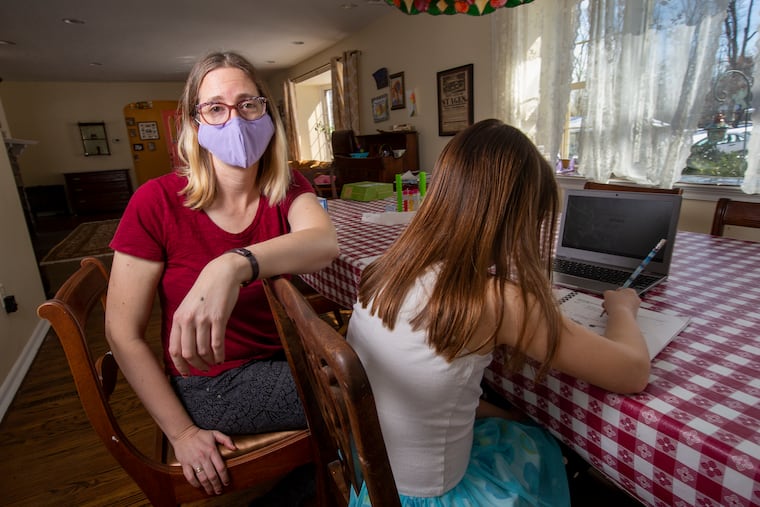I am ‘bone-crushingly tired’ after a year of pandemic parenting | Opinion
Now we have to be public health experts, making (what feels like) potentially life or death decisions for our families.

I am so tired. Like, bone-crushingly tired.
I’m now entering my second year of pandemic parenting. I have a pretty good setup: My 7-year-old had backyard chickens and a swing set long before the rush for both last spring. Since the fall, her first grade, in the Cheltenham School District, ran virtual school with military precision, and kept her occupied for long stretches until early afternoon. We have steady housing and I can work remotely, leaving my days flexible to practice addition and subtraction, reenact Project Runway fashion shows with Barbies (Ken as Tim Gunn, of course), build dollhouses out of Amazon cardboard, and make about 1,000 batches of slime.
But still. I have spent a year trying to cram a full day of work into early mornings, late nights, and the blissful stretches of time my daughter was occupied. We have no local grandparents or extended family to bubble with, so our world feels very, very small. By around 4 in the afternoon, I am so exhausted, I often can do nothing but slump with her on the couch, watch TV, and count the minutes until bedtime.
» READ MORE: Pandemic life may have lasting effects on babies, but it’s taking an even greater toll on their parents
Finally, a light appeared in the dark, dark tunnel of our lives: School was reopening on Feb. 1. Amid months of built-up exhaustion — and a deep, guttural yearning for stretches of time to myself — I had to decide: Should I send her back?
It’s a question many families are asking, as Philadelphia is set to announce on March 1 when kids in prekindergarten through second grade can return. But it’s one parents may be too tired to answer with any confidence.
For nearly a year, society has asked working parents to be model employees, child-care providers, and educators — all at the same time. Now we have to be public health experts, making (what feels like) potentially life-or-death decisions for our families. It’s just too much.
Yet, as with everything during COVID-19, I scraped together whatever time and energy I could to get it done. I trusted my daughter’s school to have the resources it needed, like proper ventilation, PPE for teachers, and soap. (Families at Philly schools might not feel the same.) I talked to parents who had already made the decision. I found data showing that if an infected person goes to school, the odds of spread appear to be low. But still ... what if?
Ultimately, I signed her up for in-person school. If the worst happened, and she got sick, our small circle — with no grandparents or at-risk family — would minimize the damage. Then as the day approached, I had doubts. What about the new, more contagious variants of the virus? For 11 months, the locked doors of her school told us it wasn’t safe for her to return. That mind-set was hard to shake.
On the drive to the first day of in-person school, I asked my daughter how she felt. “Excited, but a bit nervous too,” she said. (We decided to call the feeling “nerve-cited.”) The car line was a bit chaotic, so we sat in front of the school for at least 30 minutes, waiting to reach the drop-off point. She spent most of the time silent, staring out the window at the building she knew so well but hadn’t been inside for nearly a year, her mask covering her nose and mouth like a knight in armor waiting for battle.
It’s not a war, but it’s not typical first grade, either. She eats lunch in a cafeteria that now looks like a room for standardized tests, with rows of individual desks placed six feet apart. There’s music during lunch to discourage talking, and circulating adults shush non-compliers. She brings in a few toys from home in a Ziploc bag, so she can play alone at her desk when it’s too cold or icy to spend recess outside. She and her best friend — whom she hadn’t seen in 11 months — make presents for each other, which she tells me they have to slide across the floor so they don’t get too close. Still, when I ask how her day was, after she climbs back into the car, her mask wrinkled and grimy (but still covering her nose and mouth), she says the same thing: “good.”
“It’s not a war, but it’s not typical first grade, either.”
She spends a lot less time at school than I had imagined. There is no in-person instruction on Wednesdays, and with snow days, holidays, and professional development, she had six days in-person between Feb. 1 and Feb. 21. If she has an exposure, that will cut into her at-school time even more. I should be grateful for every day I get: Cheltenham High went back to all-virtual instruction after only two days in-person, when nearly one-quarter of the teachers called out.
I’m still nervous (or “nerve-cited”) about sending my daughter to school. Until she gets vaccinated without getting COVID-19, I will wonder if I made the right choice.
She is more sure. At a routine doctor’s visit 10 days into her return, he asked her if she preferred doing school at home or in school. “School,” she said, without missing a beat.
Alison McCook is a journalist based in Wyncote and a commentary editor at Knowable Magazine, a science publication for a general audience.